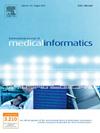Development and validation of a machine learning-based clinical prediction model for monitoring liver injury in patients with pan-cancer receiving immunotherapy
IF 4.1
2区 医学
Q2 COMPUTER SCIENCE, INFORMATION SYSTEMS
International Journal of Medical Informatics
Pub Date : 2025-07-05
DOI:10.1016/j.ijmedinf.2025.106036
引用次数: 0
Abstract
Background
Immune checkpoint inhibitor (ICI)-related liver injury poses a considerable clinical challenge for cancer patients. This study aimed to develop and validate an interpretable predictive model employing machine learning (ML) algorithms to accurately identify patients at high risk of acute liver injury within one month of initiating ICI treatment.
Methods
This longitudinal cohort study included pan-cancer patients who received their first ICI treatment between March 2019 and September 2022 at Zhongshan Hospital. Six ML algorithms, namely neural networks (NN), gradient boosting classifier (GBC), eXtreme gradient boosting (XGBoost), logistic regression (LR), categorical boosting classifier (CatBoost) and random forest (RF), were utilized to construct predictive models for acute ICI-related liver injury. Model performance was evaluated using the area under the receiver operating characteristic curve (AUC), accuracy, sensitivity, specificity, positive predictive value (PPV), negative predictive value (NPV) and brier score (BS). The SHapley Additive exPlanations (SHAP) method was applied to rank the feature importance and interpret the final model, providing insights into the contribution of each feature to liver injury prediction, thereby enhancing clinical interpretability. This study is registered with the Chinese Clinical Trial Registry (ChiCTR2300067470).
Results
A total of 863 patients were enrolled in the study, with 22.71% experiencing liver injury within one month of ICI initiation. Among the six preliminary models, the RF model exhibited the best performance and was selected for the development of the final model. The SHAP method was utilized to rank variables from the six pre-models, with 10 variables selected for the final model by identifying the intersection of the top 20 most important variables across these models. The final RF model exhibited robust performance, achieving an AUC of 0.81 (95% CI: 0.73–0.90) on the test set, and 0.79 (95% CI: 0.72–0.88) and 0.80 (95% CI: 0.72–0.89) in the 5-fold and 10-fold cross-validation, respectively. The Decision Curve Analysis (DCA) curve illustrated solid clinical benefit, and the calibration curve reflected good predictive consistency.
Conclusion
An interpretable RF model was developed to predict acute liver injury occurring within one month after ICI treatment. This clinical-friendly model enables early identification of high-risk patients, facilitating optimized clinical management and ultimately improving treatment outcomes.
开发和验证基于机器学习的临床预测模型,用于监测接受免疫治疗的泛癌患者的肝损伤
免疫检查点抑制剂(ICI)相关的肝损伤对癌症患者提出了相当大的临床挑战。本研究旨在开发和验证一种可解释的预测模型,该模型采用机器学习(ML)算法,在开始ICI治疗的一个月内准确识别急性肝损伤高风险患者。方法本纵向队列研究纳入2019年3月至2022年9月在中山医院接受首次ICI治疗的泛癌患者。利用神经网络(NN)、梯度增强分类器(GBC)、极限梯度增强分类器(XGBoost)、逻辑回归(LR)、分类增强分类器(CatBoost)和随机森林(RF)等6种ML算法构建急性ci相关性肝损伤预测模型。采用受试者工作特征曲线下面积(AUC)、准确性、敏感性、特异性、阳性预测值(PPV)、阴性预测值(NPV)和brier评分(BS)评价模型的性能。采用SHapley加性解释(SHAP)方法对特征重要性进行排序并解释最终模型,从而深入了解每个特征对肝损伤预测的贡献,从而提高临床可解释性。本研究已在中国临床试验注册中心注册(ChiCTR2300067470)。结果共纳入863例患者,其中22.71%的患者在ICI开始一个月内出现肝损伤。在六个初步模型中,射频模型表现出最好的性能,并被选中用于最终模型的开发。利用SHAP方法对六个预模型中的变量进行排序,通过识别这些模型中最重要的前20个变量的交集,选择10个变量作为最终模型。最终的RF模型表现出稳健的性能,在测试集上实现了0.81 (95% CI: 0.73-0.90)的AUC,在5倍和10倍交叉验证中分别实现了0.79 (95% CI: 0.72-0.88)和0.80 (95% CI: 0.72-0.89)。决策曲线分析(DCA)曲线显示了可靠的临床效益,校准曲线反映了良好的预测一致性。结论建立了一种可解释的射频模型,用于预测ICI治疗后1个月内发生的急性肝损伤。这种临床友好型模型可以早期识别高危患者,促进优化临床管理,最终改善治疗效果。
本文章由计算机程序翻译,如有差异,请以英文原文为准。
求助全文
约1分钟内获得全文
求助全文
来源期刊

International Journal of Medical Informatics
医学-计算机:信息系统
CiteScore
8.90
自引率
4.10%
发文量
217
审稿时长
42 days
期刊介绍:
International Journal of Medical Informatics provides an international medium for dissemination of original results and interpretative reviews concerning the field of medical informatics. The Journal emphasizes the evaluation of systems in healthcare settings.
The scope of journal covers:
Information systems, including national or international registration systems, hospital information systems, departmental and/or physician''s office systems, document handling systems, electronic medical record systems, standardization, systems integration etc.;
Computer-aided medical decision support systems using heuristic, algorithmic and/or statistical methods as exemplified in decision theory, protocol development, artificial intelligence, etc.
Educational computer based programs pertaining to medical informatics or medicine in general;
Organizational, economic, social, clinical impact, ethical and cost-benefit aspects of IT applications in health care.
 求助内容:
求助内容: 应助结果提醒方式:
应助结果提醒方式:


